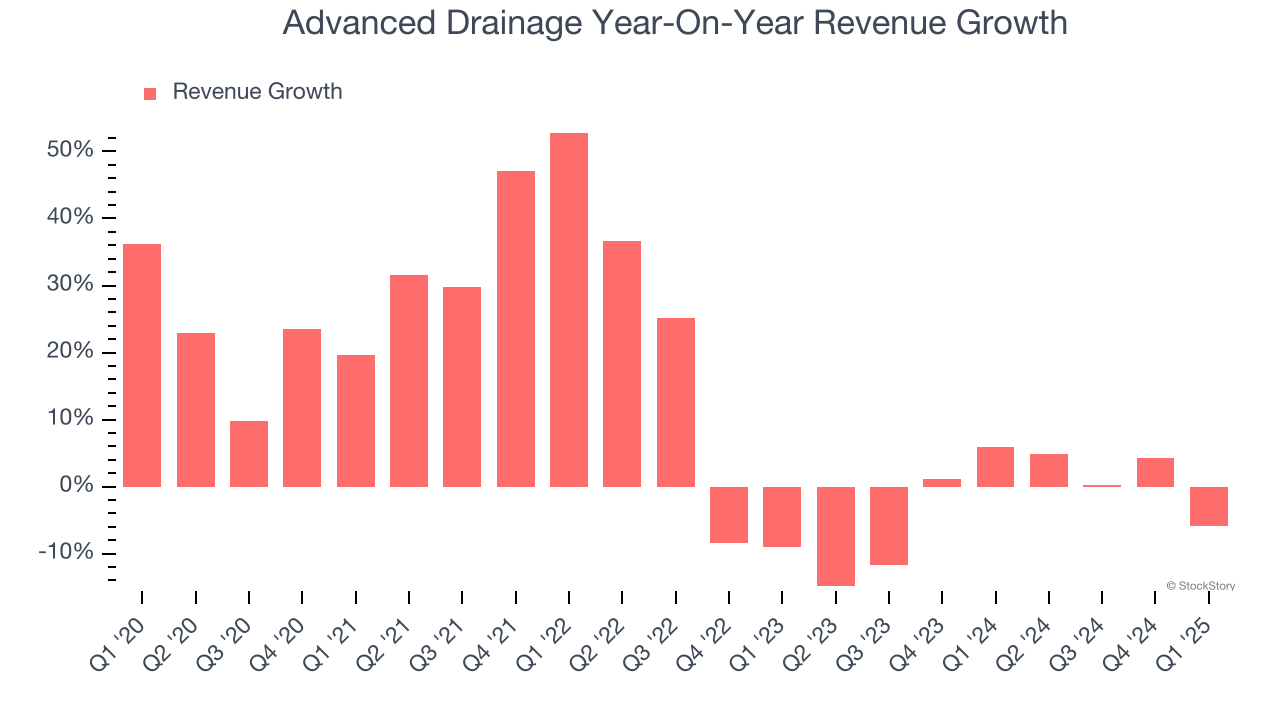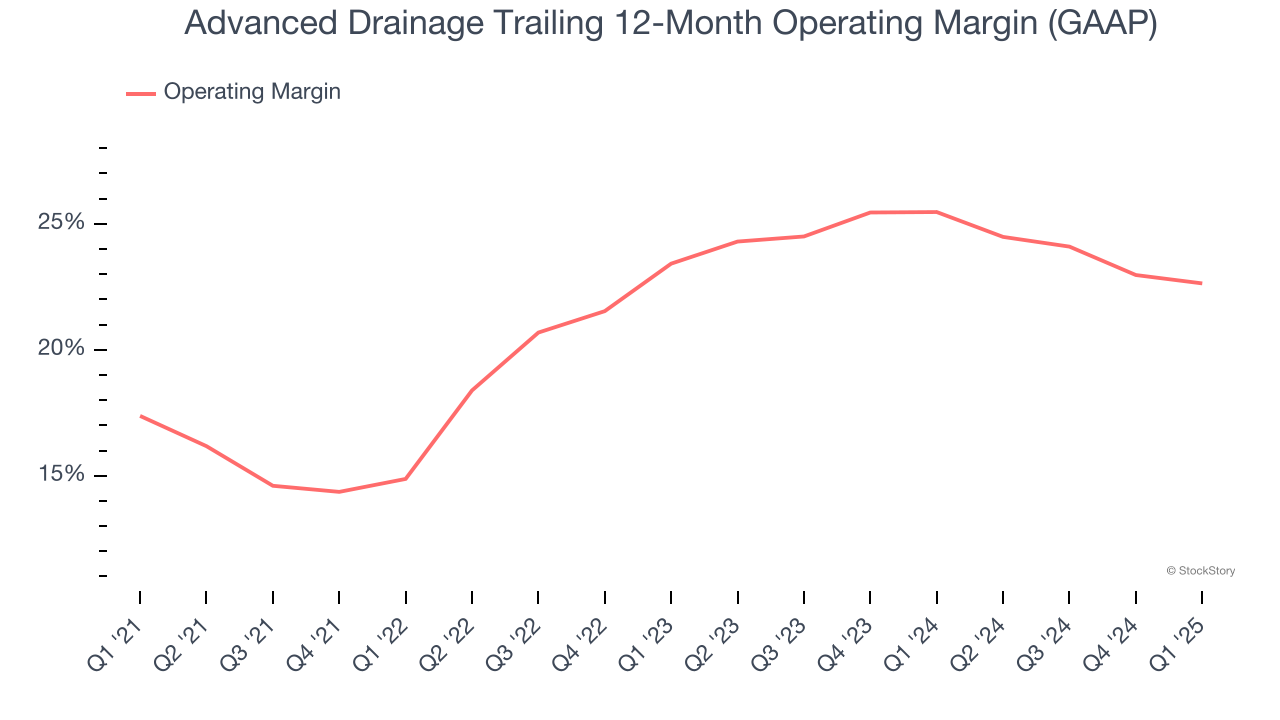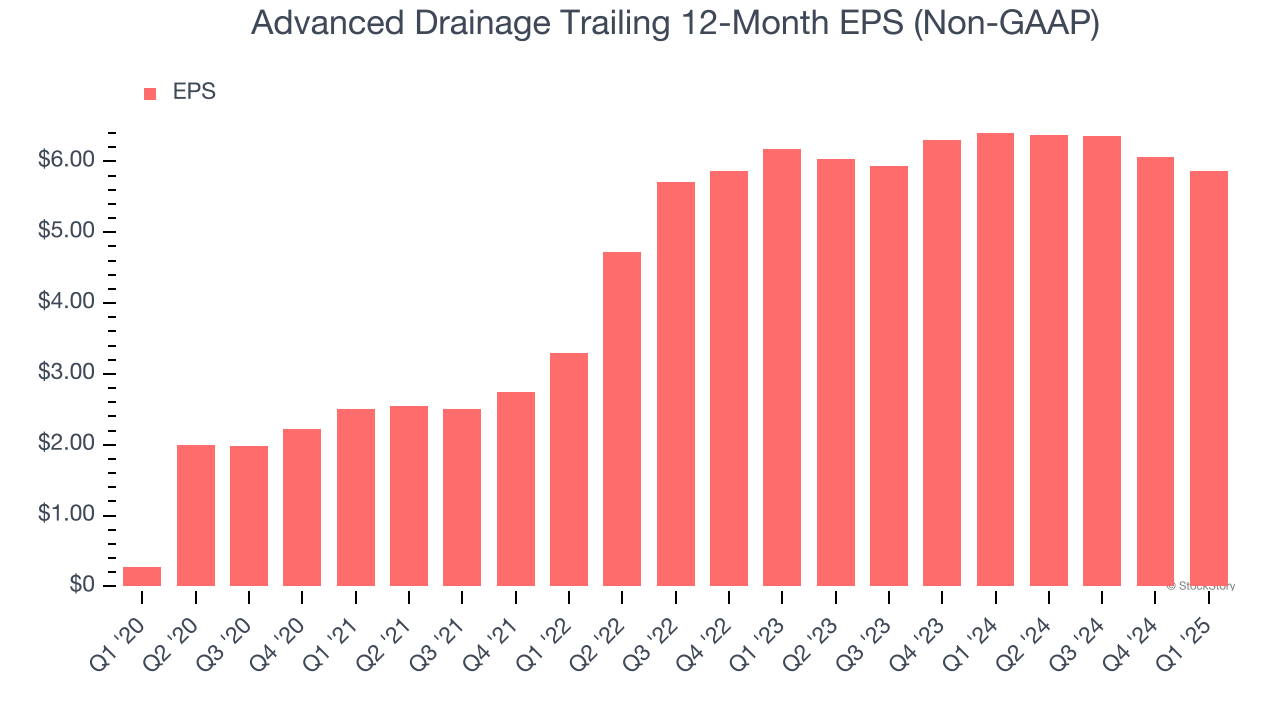
Water management company Advanced Drainage Systems (NYSE: WMS) missed Wall Street’s revenue expectations in Q1 CY2025, with sales falling 5.8% year on year to $615.8 million. The company’s full-year revenue guidance of $2.9 billion at the midpoint came in 7.6% below analysts’ estimates. Its non-GAAP profit of $1.03 per share was 6.2% below analysts’ consensus estimates.
Is now the time to buy Advanced Drainage? Find out by accessing our full research report, it’s free.
Advanced Drainage (WMS) Q1 CY2025 Highlights:
- Revenue: $615.8 million vs analyst estimates of $660.4 million (5.8% year-on-year decline, 6.8% miss)
- Adjusted EPS: $1.03 vs analyst expectations of $1.10 (6.2% miss)
- Adjusted EBITDA: $176.7 million vs analyst estimates of $184.1 million (28.7% margin, 4% miss)
- Management’s revenue guidance for the upcoming financial year 2026 is $2.9 billion at the midpoint, missing analyst estimates by 7.6% and implying -0.1% growth (vs 0.9% in FY2025)
- EBITDA guidance for the upcoming financial year 2026 is $880 million at the midpoint, below analyst estimates of $937.6 million
- "demand continues to be impacted by higher interest rates and economic uncertainty. In addition, the fourth quarter had unfavorable winter weather conditions this year against an already difficult comparison of very favorable weather in the prior year"
- Operating Margin: 19%, down from 20.7% in the same quarter last year
- Free Cash Flow was -$5.31 million compared to -$29.76 million in the same quarter last year
- Market Capitalization: $9.44 billion
Scott Barbour, President and Chief Executive Officer of ADS, commented, "In Fiscal 2025, domestic construction market sales increased 3% as we continued to drive above market performance through our material conversion strategy in the stormwater and onsite wastewater markets. Importantly, organic sales in our most profitable segments, Infiltrator and Allied Products, increased 4.6% and 2.5%, respectively, and the onsite wastewater and Allied products now represent a collective 44% of revenue. The resiliency demonstrated by this year's 30.6% Adjusted EBITDA margin is due in part to our strategy to grow these more profitable products to be a higher mix of the overall sales."
Company Overview
Originally started as a farm water drainage company, Advanced Drainage Systems (NYSE: WMS) provides clean water management solutions to communities across America.
Sales Growth
A company’s long-term sales performance is one signal of its overall quality. Even a bad business can shine for one or two quarters, but a top-tier one grows for years. Over the last five years, Advanced Drainage grew its sales at an impressive 11.7% compounded annual growth rate. Its growth beat the average industrials company and shows its offerings resonate with customers.

Long-term growth is the most important, but within industrials, a half-decade historical view may miss new industry trends or demand cycles. Advanced Drainage’s recent performance marks a sharp pivot from its five-year trend as its revenue has shown annualized declines of 2.8% over the last two years. 
Advanced Drainage also breaks out the revenue for its most important segments, Pipe and Infiltrators, which are 51.7% and 19.9% of revenue. Over the last two years, Advanced Drainage’s Pipe revenue (thermoplastic corrugated pipes) averaged 6.6% year-on-year declines. On the other hand, its Infiltrators revenue (wastewater treatment systems) averaged 10% growth.
This quarter, Advanced Drainage missed Wall Street’s estimates and reported a rather uninspiring 5.8% year-on-year revenue decline, generating $615.8 million of revenue.
Looking ahead, sell-side analysts expect revenue to grow 6.2% over the next 12 months. While this projection implies its newer products and services will catalyze better top-line performance, it is still below average for the sector.
Today’s young investors won’t have read the timeless lessons in Gorilla Game: Picking Winners In High Technology because it was written more than 20 years ago when Microsoft and Apple were first establishing their supremacy. But if we apply the same principles, then enterprise software stocks leveraging their own generative AI capabilities may well be the Gorillas of the future. So, in that spirit, we are excited to present our Special Free Report on a profitable, fast-growing enterprise software stock that is already riding the automation wave and looking to catch the generative AI next.
Operating Margin
Operating margin is an important measure of profitability as it shows the portion of revenue left after accounting for all core expenses – everything from the cost of goods sold to advertising and wages. It’s also useful for comparing profitability across companies with different levels of debt and tax rates because it excludes interest and taxes.
Advanced Drainage has been a well-oiled machine over the last five years. It demonstrated elite profitability for an industrials business, boasting an average operating margin of 21.1%. This result isn’t too surprising as its gross margin gives it a favorable starting point.
Analyzing the trend in its profitability, Advanced Drainage’s operating margin rose by 5.3 percentage points over the last five years, as its sales growth gave it immense operating leverage.

In Q1, Advanced Drainage generated an operating profit margin of 19%, down 1.7 percentage points year on year. Since Advanced Drainage’s gross margin decreased more than its operating margin, we can assume its recent inefficiencies were driven more by weaker leverage on its cost of sales rather than increased marketing, R&D, and administrative overhead expenses.
Earnings Per Share
Revenue trends explain a company’s historical growth, but the long-term change in earnings per share (EPS) points to the profitability of that growth – for example, a company could inflate its sales through excessive spending on advertising and promotions.
Advanced Drainage’s EPS grew at an astounding 83.9% compounded annual growth rate over the last five years, higher than its 11.7% annualized revenue growth. This tells us the company became more profitable on a per-share basis as it expanded.

We can take a deeper look into Advanced Drainage’s earnings to better understand the drivers of its performance. As we mentioned earlier, Advanced Drainage’s operating margin declined this quarter but expanded by 5.3 percentage points over the last five years. This was the most relevant factor (aside from the revenue impact) behind its higher earnings; taxes and interest expenses can also affect EPS but don’t tell us as much about a company’s fundamentals.
Like with revenue, we analyze EPS over a shorter period to see if we are missing a change in the business.
For Advanced Drainage, its two-year annual EPS declines of 2.5% mark a reversal from its (seemingly) healthy five-year trend. We hope Advanced Drainage can return to earnings growth in the future.
In Q1, Advanced Drainage reported EPS at $1.03, down from $1.23 in the same quarter last year. This print missed analysts’ estimates, but we care more about long-term EPS growth than short-term movements. Over the next 12 months, Wall Street expects Advanced Drainage’s full-year EPS of $5.87 to grow 7.7%.
Key Takeaways from Advanced Drainage’s Q1 Results
We struggled to find many positives in these results. Its Infiltrators revenue missed and its full-year revenue guidance fell short of Wall Street’s estimates. Management stated that "demand continues to be impacted by higher interest rates and economic uncertainty. In addition, the fourth quarter had unfavorable winter weather conditions this year against an already difficult comparison of very favorable weather in the prior year". Overall, this was a weaker quarter. The stock remained flat at $120.69 immediately following the results.
Advanced Drainage may have had a tough quarter, but does that actually create an opportunity to invest right now? What happened in the latest quarter matters, but not as much as longer-term business quality and valuation, when deciding whether to invest in this stock. We cover that in our actionable full research report which you can read here, it’s free.





